Imagine the artistry of designing a skyscraper—where form meets function, and engineering brilliance touches the sky. In the world of software, architecture patterns serve as the architect’s compass, guiding development of robust and maintainable systems.
Software architecture patterns offer reusable designs for various situations, offering numerous advantages such as improved efficiency, productivity, speed, cost optimization, and better planning.
One notable example of a successful architecture pattern is Amazon. Amazon leveraged event-driven architecture to trigger actions and handle asynchronous communication between services.
This approach allowed Amazon to build loosely coupled systems to handle large-scale traffic and respond to events in real-time.
To assist you in choosing the right pattern for your project, we have compiled and summarized ten software architectural design patterns in this blog.
What is an architectural pattern?
An architectural pattern is a set of architectural design decisions that address recurring design problems in various software development contexts. It offers rules and principles for organizing the interactions between predefined subsystems and their roles.
Even though an architectural pattern is a rough image or blueprint of your system, it’s not the actual architecture. Instead, it’s a concept that helps you to understand software architecture’s elements. There can be countless pieces of architecture that implement the same pattern. That’s why patterns are known as “strictly described and commonly utilized.” The success of the system depends on software architecture selection.
Famous examples of architectural patterns are microservices, message bus, service requester/ consumer, MVC pattern, MVVM, microkernel, n-tier, domain-driven design components, and presentation-abstraction-control.
What is the importance of software architecture pattern?
Software architecture patterns hold significant importance for it can solve various problems within different domains. For instance, instead of depending on a single server, complex user requests can be easily segmented into smaller chunks and distributed across multiple servers. In another example, testing protocols can be simplified by dividing various segments of the software rather than testing the whole thing at once.
Here are some more reasons why software architecture patterns are vital for any software application:
-
Defining Basic Characteristics of an Application:
Knowing each architecture’s characteristics, strengths, and weaknesses becomes important for choosing the right one to meet your business objectives. It has been observed that architecture patterns help define an application’s basic characteristics and behaviors. For instance, some architecture patterns can be naturally used for highly scalable applications, whereas others can be used for agile applications.
-
Maintaining Quality and Efficiency:
There is a high possibility that any application you build might face quality issues. According to your software development quality attributes, selecting an architecture pattern can help minimize the quality issues alongwith maintaining efficiency.
-
Providing Agility:
It is natural for software applications to undergo numerous modifications and iterations during software development and even after production. Therefore, planning a core software architecture beforehand provides agility to the application and makes future moderations effortless.
-
Problem Solving:
Prior planning and knowledge of a software architecture give a clear idea of how the application and its components will function. With an architecture in place, the developing team can adopt the best practices to resolve complex processes and solve any errors in the future.
-
Enhancing Productivity:
Irrespective of the skills and knowledge one has about a programming language, framework, or application, there has to be certain standardized principles. With an appropriate application pattern in place, the company can quickly grasp the project’s status. In addition, productivity rates improve when an architecture pattern is in place to clarify the project scope.
Software architecture pattern vs. design pattern
There is a thin line between an architecture pattern and a design pattern, and most people get confused between the two. For basics, let’s imagine your team given a task to build a house and live in it.
To begin with the task, they would first have to plan it out before placing bricks and cement on an empty ground. Moreover, even after a house is planned, there is more to making it worth living – they would need basic amenities like kitchen appliances, beddings, toiletries, and many more. In this analogy, how the house should look represents architectural patterns, whereas the interior design of the house represents the design patterns.
In a software system, architecture is considered when you have to create business logic, database logic, UI, etc., whereas software design patterns are used while implementing business logic or database logic.
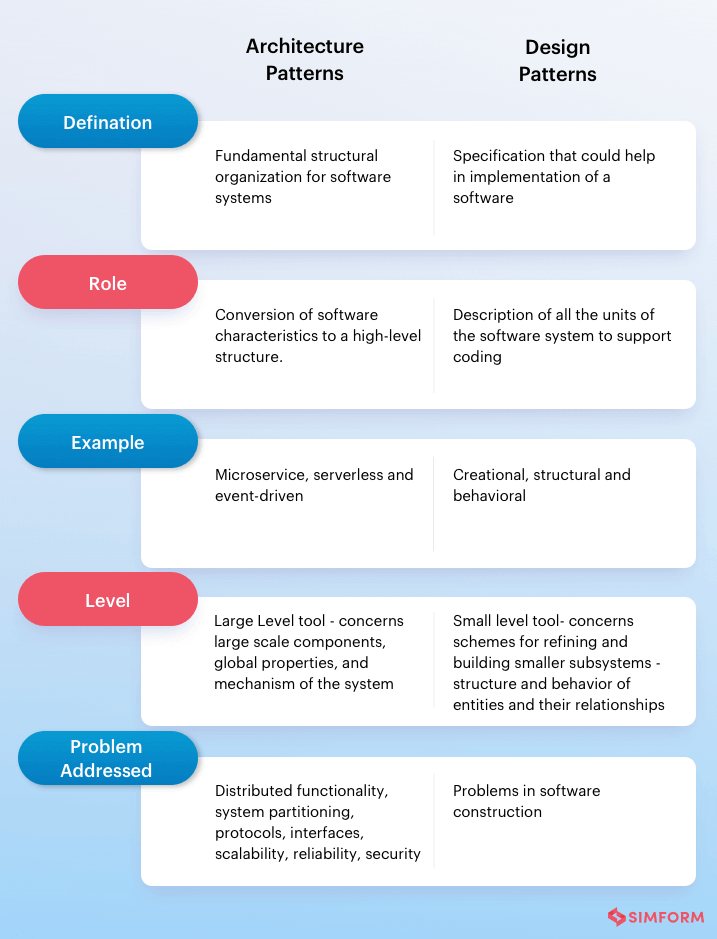
Different types of software architecture pattern
1. Layered Architecture Pattern
You’ve probably heard of multi-layered, aka tiered architecture, or n-tier architecture. This architecture has gained popularity amongst designers and software architects alike for its commonalities with the conventional arrangements of IT communications in many startups and established enterprises. Often, a layered architecture is classified into four distinct layers: presentation, business, persistence, and database; however, the pattern is not confined to the specified layers and there can be an application layer or service layer or data access layer. Popular frameworks like Java EE utilized this architecture pattern.
Let’s say a software engineer is building a large application, and you employed all four layers to your architecture pattern. On the flip side, small businesses may combine the business and the persistence layers into a single unit, primarily when the latter is engaged as an integral part of the business logic layer components.
This pattern stands out because each layer plays a distinct role within the application and is marked as closed. It means a request must pass through the layer below it to go to the next layer. Another one of its concepts – layers of isolation – enables you to modify components within one layer without affecting the other layers.
To simplify this process, let’s take an example of an eCommerce web application. The business logic required to process a shopping cart activity, such as calculating the cart, is directly fetched from the application tier to the presentation tier. Here the application tier acts as an integration layer to establish seamless communication between the data and presentation layers. Additionally, the last tier is the data tier used to maintain data independently without the intervention of the application server and the business logic.
Usage:
- Applications that are needed to be built quickly.
- Enterprise applications that require traditional IT departments and processes.
- Appropriate for teams with inexperienced developers and limited knowledge of architecture patterns.
- Applications that require strict standards of maintainability and testability.
Shortcomings:
- Unorganized source codes and modules with no definite roles can become a problem for the application.
- Skipping previous layers to create tight coupling can lead to a logical mess full of complex interdependencies.
- Basic modifications can require a complete redeployment of the application.
Diagram:
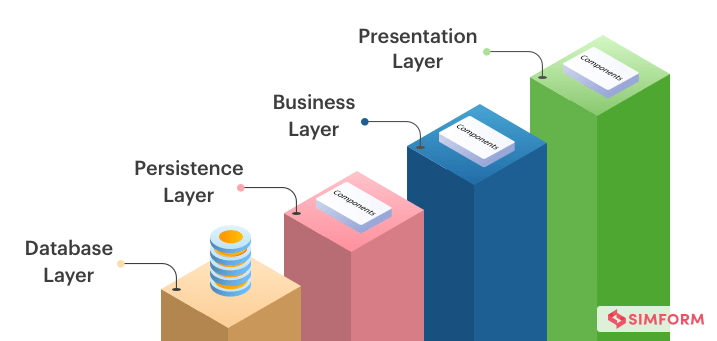
2. Event-driven Architecture Pattern
If you are looking for an architecture pattern that is agile and highly performant, then you should opt for an event-driven architecture pattern. It is made up of decoupled, single-purpose event processing components that asynchronously receive and process events. This pattern orchestrates the behavior around the production, detection, and consumption of all the events, along with the responses they evoke.
The event-driven architectural style consists of two topologies – mediator and broker. A mediator is used when multiple steps are needed to be orchestrated within an event bus through a central mediator. On the other hand, a broker is used to chain events together without using a central mediator.
A good example that uses event-driven architecture is an e-commerce site. The event-driven architecture enables the e-commerce website to react to various sources at a time of high demand. Simultaneously, it avoids any crash of the application or any over-provisioning of resources.
Usage:
- For applications where individual data blocks interact with only a few modules.
- Helps with user interfaces.
Shortcomings:
- Testing individual modules can only be done if they are independent, otherwise, they need to be tested in a fully functional system.
- When several modules are handling the same events, error handling becomes challenging to structure.
- Development of a system-wide data structure for events can become arduous if the events have different needs.
- Maintaining a transaction-based mechanism for consistency can become complex with decoupled and independent modules.
Diagram:
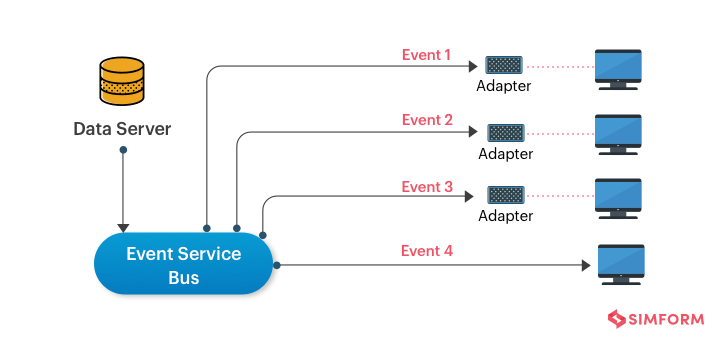
3. Microkernel Architecture Pattern
This architecture pattern consists of two types of components – a core system and several plug-in modules. While the core system works on minimal functionality to keep the system operational, the plug-in modules are independent components with specialized processing.
If we take a business application’s perspective, the core system can be defined as general business logic without the custom code for special cases, special rules, or complex conditional processes. On the other hand, the plug-in modules are meant to enhance the core system in order to produce additional business capabilities.
Taking the example of a task scheduler application, the microkernel contains all the logic for scheduling and triggering tasks, while the plug-ins contain specific tasks. As long as the plug-ins adhere to a predefined API, the microkernel can trigger them without having to know the implementation details.
Usage:
- Applications that have a clear segmentation between basic routines and higher-order rules.
- Applications that have a fixed set of core routines and dynamic set of rules that needs frequent updates.
Shortcoming:
- The plugins must have good handshaking code so that the microkernel is aware of the plugin installation and is ready to work.
- Changing a microkernel is almost impossible if multiple plugins depend on it.
- It is difficult to choose the right granularity for the kernel function in advance and more complex at a later stage.
Diagram:
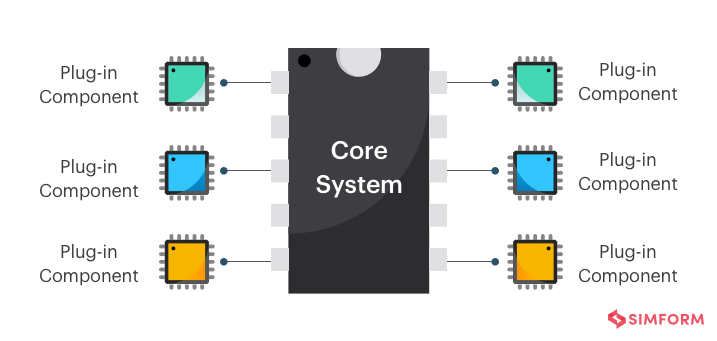
4. Microservices Architecture Pattern
Microservices architecture pattern is seen as a viable alternative to monolithic applications and service-oriented architectures. The components are deployed as separate units through an effective, streamlined delivery pipeline. The pattern’s benefits are enhanced scalability and a high degree of decoupling within the application.
Owing to its decoupled and independent characteristics, the components are accessed through a remote access protocol. Moreover, the same components can be separately developed, deployed, and tested without interdependency on any other service component.
Netflix is one of the early adopters of the microservice architecture pattern. The architecture allowed the engineering team to work in small teams responsible for the end-to-end development of hundreds of microservices. These microservices work together to stream digital entertainment to millions of Netflix customers every day.
Usage:
- Businesses and web applications that require rapid development.
- Websites with small components, data centers with well-defined boundaries, and remote teams globally.
Shortcoming:
- Designing the right level of granularity for a service component is always a challenge.
- All applications do not include tasks that can be split into independent units.
- Performance can be affected because of tasks being spread across different microservices.
Diagram:
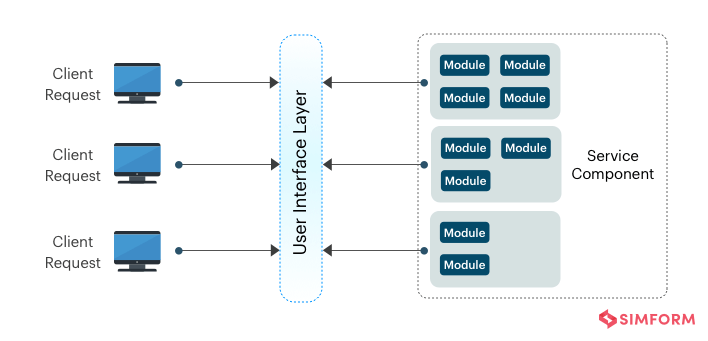
5. Space-Based Architecture Pattern
The concept of tuple space – the idea of distributed shared memory is the basis of the name of this architecture. The space-based pattern comprises two primary components – a processing unit and a virtualized middleware.
The processing unit contains portions of application components, including web-based components and backend business logic. While smaller web applications could be deployed in a single processing unit, the larger applications could split the application functionality into multiple processing units to avoid functional collapse. Furthermore, the virtualized-middleware component contains elements that control various aspects of data synchronization and request handling. They can be custom-written or can be purchased as third-party products.
A bidding auction site can be considered as a fitting example for this architecture pattern. It functions as the site receives bids from internet users through a browser request. On receiving the request, the site records that bid with a timestamp, updates the information of the latest bid, and sends the data back to the browser.
Usage:
- Applications and software systems that function with a large user base and a constant load of requests.
- Applications that are supposed to address scalability and concurrency issues.
Shortcoming:
- It is a complex task to cache the data for speed without disturbing multiple copies.
Diagram:
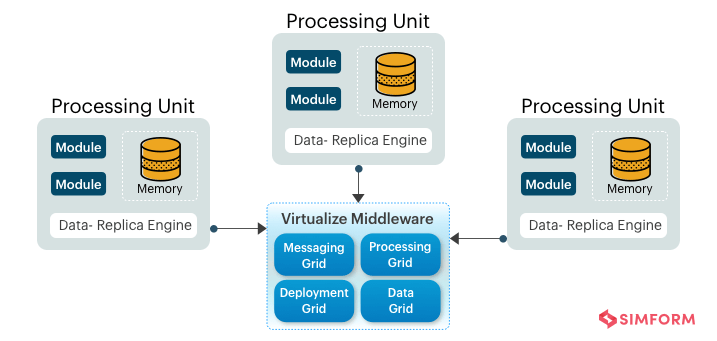
6. Client-Server Architecture Pattern
A client-server architecture pattern is described as a distributed application structure having two main components – a client and a server. This architecture facilitates the communication between the client and the server, which may or may not be under the same network. A client requests specific resources to be fetched from the server, which might be in the form of data, content, services, files, etc. The server identifies the requests made and responds to the client appropriately by sending over the requested resources.
The functional characteristics of a client and a server is an example of programs that interact with one another within an application. The functionality of this architecture is highly flexible as a single server can serve multiple clients, or a single client can use multiple servers. The servers can be classified by the services or resources they provide, irrespective of how they perform.
Email is a prominent example of a model that is built using the client-server pattern. When a user/client searches for a particular email, the server looks into the pool of resources and sends the requested email resource back to the user/client. This also helps you to improve the user experience.
Usage:
- Applications like emails, online banking services, the World Wide Web, network printing, file sharing applications, gaming apps, etc.
- Applications that focus on real-time services like telecommunication apps are built with a distributed application structure.
- Applications that require controlled access and offer multiple services for a large number of distributed clients.
- An application with centralized resources and services that has to be distributed over multiple servers.
Shortcomings:
- Incompatible server capacity can slow down, causing a performance bottleneck.
- Servers are usually prone to a single point of failure.
- Changing the pattern is a complex and expensive process.
- Server maintenance can be a demanding and expensive task.
Diagram:
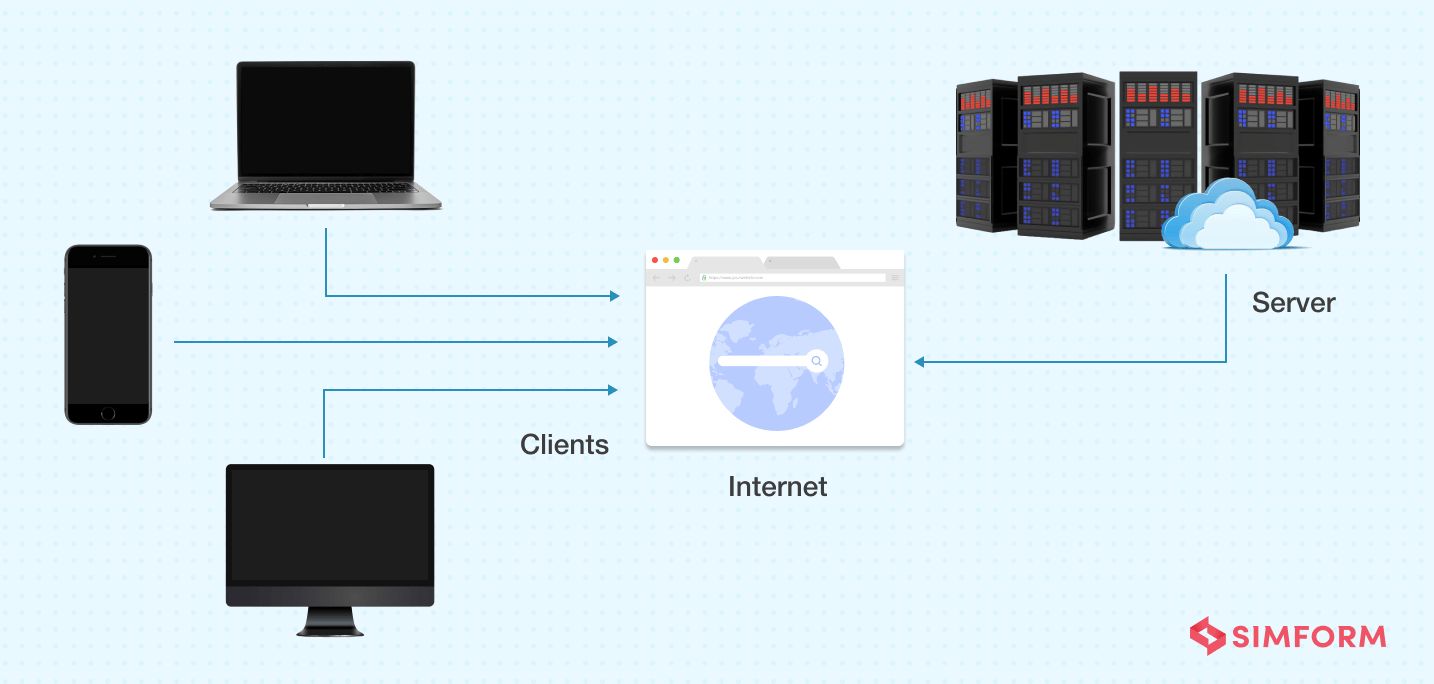
7. Master-Slave Architecture Pattern
Imagine a single database receiving multiple similar requests at the same time. Naturally, processing every single request at the same time can complicate and slow down the application process. A solution to this problem is a master-slave architecture pattern that functions with the master database launching multiple slave components to process those requests quickly.
As the title suggests, the master-slave architecture pattern can be pictured as a master distributing tasks to its slaves. Once the slave components finish their tasks, the distributed tasks are compiled by the master and displayed as the result.
One must note that the master has absolute control and power over the slave components, determining their communication and functional priorities. What makes this pattern unique is that each slave would process the requests simultaneously, providing the results at the same time. This also means that the slave operations would not be considered complete until every slave has returned the result to the master.
This pattern is well-suited for applications that can be divided into smaller segments for executing similar requests. An appropriate example would be a database application that requires heavy multitasking as its vital component.
Usage:
- Development of Operating Systems that may require a multiprocessors compatible architecture.
- Advanced applications where larger services have to be decomposed into smaller components.
- Applications processing raw data stored in different servers over a distributed network.
- Web browsers that follow multithreading to increase its responsiveness.
Shortcomings:
- Failure of the master component can lead to a loss of data with no backup over the slave components.
- Dependencies within the system can lead to a failure of the slave components.
- There can be an increase in overhead costs due to the isolated nature of the slave components.
Diagram:
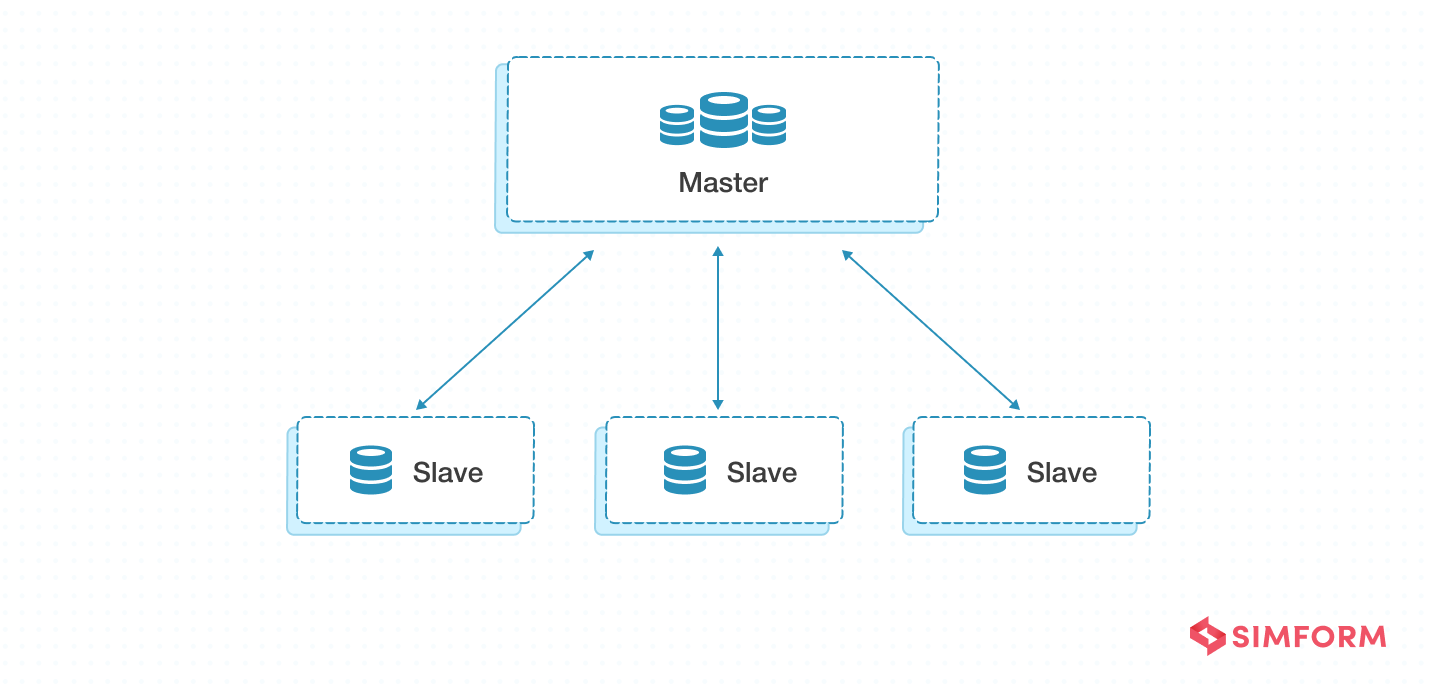
8. Pipe-Filter Architecture Pattern
A pipe-filter architecture pattern processes a stream of data in a unidirectional flow where components are referred to as filters, and pipes are those which connect these filters. The chain of processing data takes place where the pipes transmit data to the filters, and the result of one filter becomes the input for the next filter. The function of this architecture is to break down significant components/processes into independent and multiple components that can be processed simultaneously.
The pipe-filter pattern is best suited for applications that process data in a stream using web services and can create simple sequences to complex structures. Compilers can be considered a fitting example having this architecture pattern since each filter performs lexical analysis, parsing, semantic analysis, and code generation.
Usage:
- It can be used for applications facilitating a simple, one-way data processing and transformation.
- Applications using tools like Electronic Data Interchange and External Dynamic List.
- Development of data compilers used for error-checking and syntax analysis.
- To perform advanced operations in Operating Systems like UNIX, where the output and input of programs are connected in a sequence.
Shortcomings:
- There can be a loss of data in between filters if the infrastructure design is not reliable.
- The slowest filter limits the performance and efficiency of the entire architecture.
- During transmission between filters, the data-transformation overhead costs might increase.
- The continuous transformational character of the architecture makes it less user-friendly for interactional systems.
Diagram:
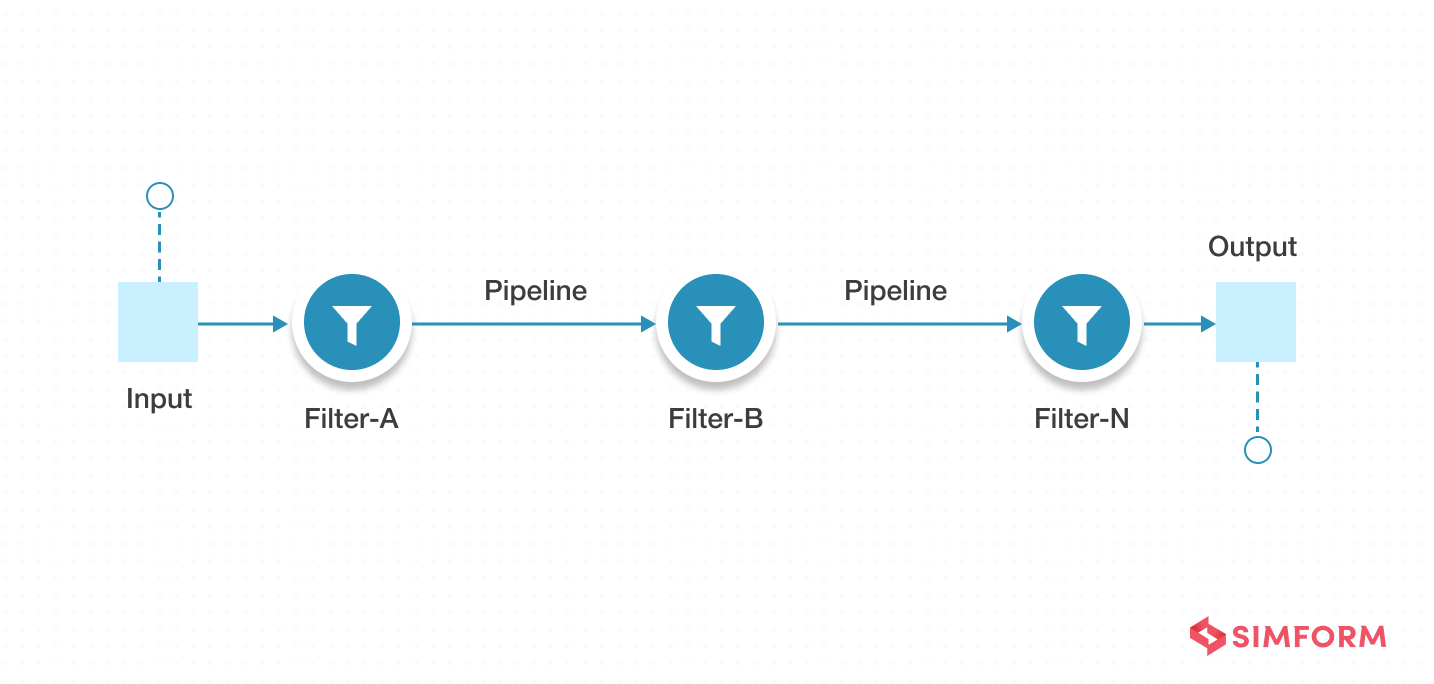
9. Broker Architecture Pattern
A broker pattern is used for structuring distributed systems with decoupled components. By invoking remote services, components can interact with others in broker architecture patterns. Also, the broker is responsible for all the coordination and communication among the components.
Clients, servers, and brokers are three major components of the broker pattern. Generally, a broker will have access to all the services and characteristics related to a particular server. When clients request a service from the broker, the broker redirects them to a suitable service category for further process.
One of the key benefits of this architecture pattern is how it manages operations, such as change, addition, deletion, or relocation, related to objects in a dynamic manner. Lastly, this architecture pattern separates all communication-related code into layers from the application, allowing applications to run on distributed or single computers. Because of such advantages, broker architecture has been prevalent.
Usage:
- Used in message broker softwares such as Apache ActiveMQ, Apache Kafka, RabbitMQ, and JBoss Messaging.
- For structuring distributed systems that have decoupled components.
Shortcomings:
- Shallow fault tolerance capacity.
- Requires standardization of service description.
- The hidden layer may decrease software performance.
- Higher latency and requires more effort in deployment.
Diagram:
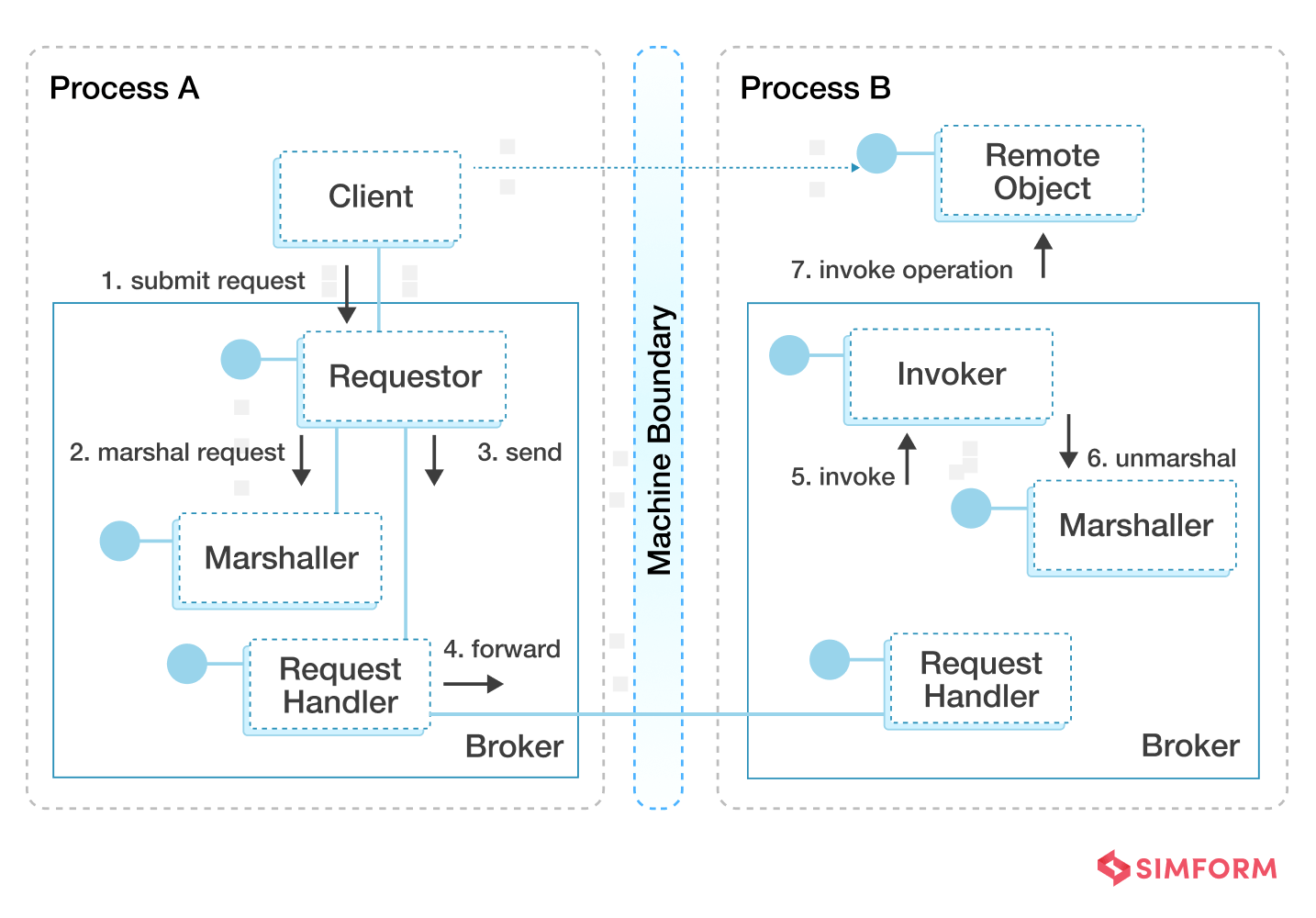
10. Peer-to-Peer Architecture Pattern
In the peer-to-peer architectural pattern, individual components are called peers. A peer can act as a client, a server, or both and change its role dynamically over time. As a client, a peer can request service from other peers, and as a server, a peer can provide services to other peers. The significant difference between peer-to-peer and client-server architecture is that each computer on the network has considerable authority and the absence of a centralized server. Its capacity increases as more and more computers join the network.
An excellent example of a peer-to-peer architecture pattern would be file-sharing networks like Skype, BitTorrent, and Napster. In BitTorrent, peer-to-peer architecture is used for distributing the data and files on the internet in a decentralized fashion. By using this protocol, one can transfer large video and audio files with the utmost ease. In Skype, you use the VoIP P2P architecture pattern to make a voice call and send text messages to another user. In this manner, you can use peer-to-peer architecture for file sharing, messaging, collaboration, etc.
Usage:
- File-sharing networks such as Gnutella and G2.
- Cryptocurrency-based products such as Bitcoin and Blockchain.
- Multimedia products such as P2PTV and PDTP.
Shortcomings:
- No guarantee of high-quality service.
- Achieving robust security is challenging.
- Performance depends on the number of nodes connected to the network.
- No way to backup files or folders.
- Might need a specific interface to read the file.
Diagram:
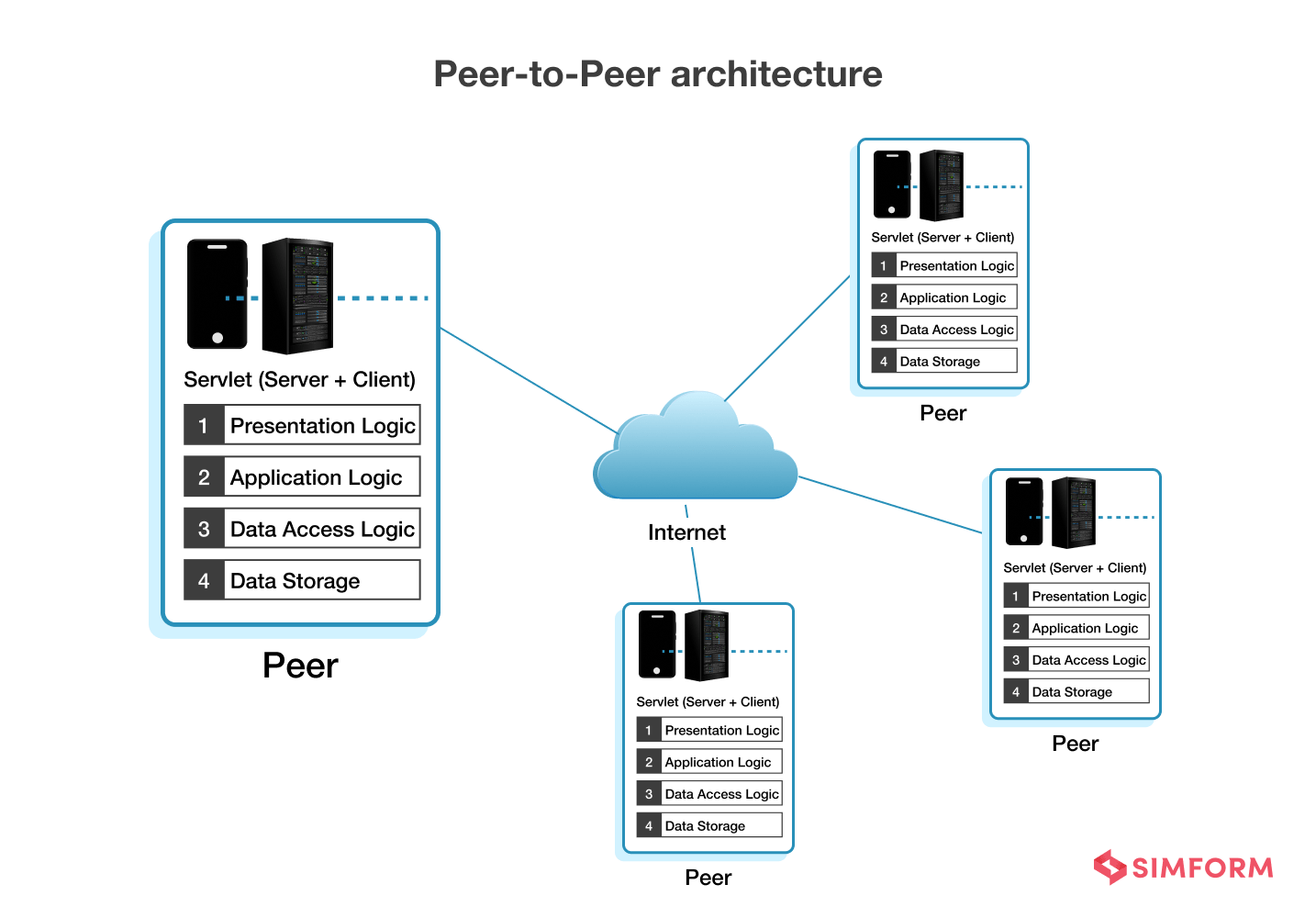
Comparative analysis of different software architecture patterns
So far, we have read about the different types of architecture patterns. Now, which architecture would you choose for your software type? You need to make the right choice.
Let’s have a glance at the table below.

Is it necessary to hire a software architect?
In my view, an “Architect” must be a senior programmer. To have an architect who doesn’t program and a handful of programmers who doesn’t know the basics of architecture is a recipe for disaster in software companies. Modern applications demand quick thinking and a standardized core that would establish a rock-hard base for the application. A software architecture pattern sets a solution-based vision for long-term goals, both for the application in question and the company.
Working with lead engineers with the knowledge of architecture helps discover the gaps in team composition, ensure effective training, and facilitate growth for the company. At Simform, we have expert engineers with excellent knowledge and experience in adopting the best architectural approaches for software projects. Our consultations have facilitated businesses in adopting the right architecture for their software application.
Reach out to us in case of any queries, and we would be happy to collaborate on your dream project. Share your thoughts with us in the comment section below.

ANIL SOMAN
Very informative article and well organized, easy-to-understand..
Jigar Panchal
Very informative
Ngounou
Very interessting article and well explained.